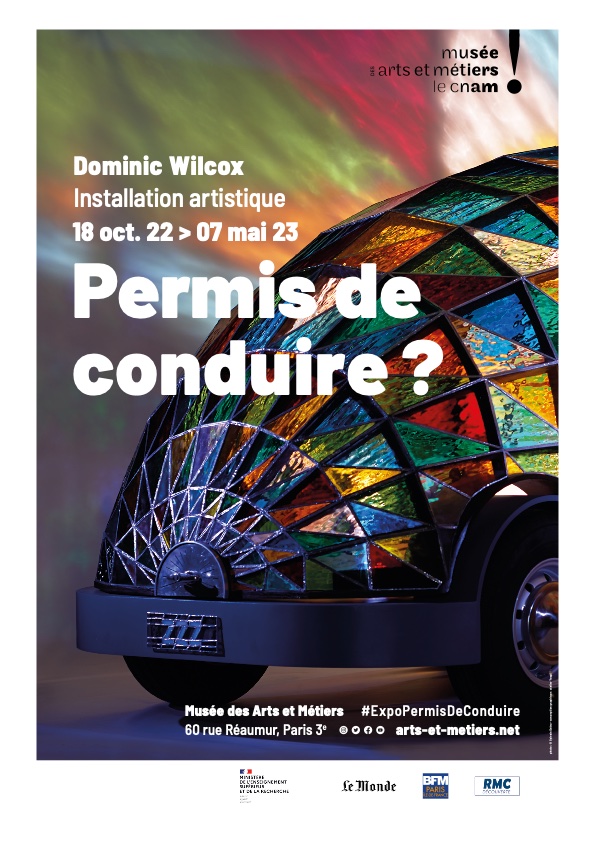Exhibition at the Musée des Arts et Métiers, Paris, France
From 18 October 2022 to 7 May 2023
While the Musée des Arts et Métiers is not strictly speaking an automobile museum, transport in general and the automobile in particular are an important component of the museum’s collections. At the end of 2022, the Musée des Arts et Métiers is launching its cultural season, dedicated to mobility around the exhibition “Permis de conduire?” (Driving license?). Who can say for sure what the car of the future will be? How are our mobility needs evolving? What are the challenges that manufacturers, public authorities and citizens will have to face in order to transform our current model? “Permis de conduire?” invites you to reflect on these questions that sometimes unleash passions. Fun and interactive, “Permis de conduire?” will be of interest to all audiences. Two small booklets for children (4-6 years old and 7-12 years old) accompany them in the exhibition and will allow them to obtain their first “Driving License”!

3 questions to Lionel Dufaux *
Why this exhibition now?
In fact, the idea of this exhibition on the automobile and its future had been in the air for several years. But we really started working on it in 2019, and 2022 seemed like a good period to us, with the expected return of the Paris Motor Show, and the ongoing changes on mobility modes and regulations.
How is the exhibition constructed?
By asking head-on the question “does the automobile still have a future? “, we wanted to challenge visitors and make them feel the complexity of the subject. The aim is to address several themes related to the automobile, always in a constructive and positive way. The exhibition is therefore separated into several spaces to address some basic techniques, the place of the automobile in our daily lives, the proposals of motorization, safety and autonomy, the automotive dream … There are many films, videos and interactive devices, to immerse the visitor and make him question himself throughout his visit. The Musee des Arts et Metiers is above all a museum of techniques, and it was therefore important to highlight the techniques without it being boring.
The Permis de conduire? exhibition is instructive, fun, positive and adapted to all audiences, including the youngest. The idea is also to then bring the visitor to continue his journey through the museum’s permanent collections, which have been slightly arranged to echo the exhibition. For example, we added cards with the exhibition image for several objects or vehicles in the permanent collections. And then, we installed two exceptional pieces: first, a “cathedral car”, combining stained glass body and autonomous driving, made by British designer Dominic Wilcox, echoing the questions raised in the exhibition; and the “Baleine” (Whale), an extraordinary automobile by Paul Arzens, impressive in its size and elegance, on display for the first time in the museum’s spaces.
What initial information do you get out of after a few weeks of opening?
First of all, a very high level of visits since the opening and the school holiday period has of course been particularly active. Secondly, we are very happy to see how the interest and even the passion for cars is still very present, even among the youngest. From the first room, with what we call the mini motor show, we feel this interest, this passion, and how the automobile is part of our lives and memories.
* Lionel Dufaux is Head of Collections at the Musée des Arts et Métiers, in charge of funds relating to energy and transport, He is the curator of the exhibition “Permis de conduire?”.
A well-paced scenography
The exhibition begins with a glance in the rearview mirror, with a miniature auto show against a backdrop of advertisements from different eras. About thirty emblematic scale models from the 1950s to the present day are installed on individual studs all set on a turntable like the stars of a stand at the auto show. Difficult choice of models, it was necessary to represent different eras, categories, brands, countries … Popular Citroën 2 CV, Ami 8, Renault R4, Mini, Volkswagen Beetle, Fiat 500 and Panda, Smart, Citroën DS and CX, Renault R20, Peugeot 504 estate, sporty Renault R8 Gordini, Peugeot 205 GTI, Alfa GTV 6, BMW M3 or Mercedes 190 2.5-16 , and many others immerse the visitor in their memories and a positive vision of the car freedom and pleasure. Deliberately provocative, the question “does the automobile have a future” will be the common thread of the rest of the exhibition.




You will continue your visit with a gas station straight out of the 1950s. A Renault 4 CV in cup is waiting to refuel. It is a unique model, presented at the 1946 auto show, and just restored after many years spent in the museum’s reserves. The cut makes it possible to see the internal structure of the car, and to see both the progress made especially in terms of safety and the similarity of architecture with current cars. The dials of the gas pumps have been replaced by screens that broadcast car advertisements, giving an overview of the changes that have also taken place in this area. In the shop windows, on one side objects related to the car: magazines, accessories, guides, documents, logos… and in the other a sample of car-inspired games and toys. Then discover the underside of the hood, through multimedia devices and self-access demonstrations to understand how an engine, brakes or gearbox works!







The next step focuses on research, whether in terms of safety, comfort or autonomy, before addressing the engines, without taking sides, but on the contrary by explaining the stakes, advantages and objective disadvantages of current options: thermal, electric or hydrogen (fuel cell). A striking contrast between Camille Jenatzi’s famous electric Jamais Contente, which in 1899 was the 1st car in the world to exceed 100 km/h, and Renault’s modular platform for electric vehicles CMF-EV, the basis of the recent Mégane E-Tech. Do not miss the fuel cell loaned by the company H2Sys, one of the leaders in this field, the opportunity to see one up close is still extremely rare! Placed next to it, an electric motor and a combustion engine make it possible to compare complexity and size of the engines.







The last stage of this journey gives way to dreams and imagination in different forms: concept cars imagined by designers, Supercars, movie cars… in the form of drawings, photos and scale-models. Suspended from the ceiling, a Citroën DS, whose underbody has been bodied, gives the impression of flying above visitors, introducing the not so distant idea of a flying car… At the other end of the spectrum, Paul Arzens‘ Egg (l’Oeuf), an electric micro-car from 1942, challenges with its ingenious design, made of aluminum and plexiglass, very avant-garde and perfect for urban mobility. At the end of the course, an interactive game offers you to create your ideal car, based on answers to questions addressed by the exhibition!






Art installations
As a counterpoint, the Musée des Arts et Métiers has chosen to highlight the work of two contemporary artists who question our relationship to the car. Based on the principle that the car becomes 100% autonomous, Dominic Wilcox offers a range of Robot Taxis adapted to the needs of the moment: sleep, work, eat, sunbathe… and realizes the Stained Glass Driverless Sleeper Car of the Future exhibited here. From 24 January 2023, Filipe Vilas-Boas presents two visual and sound works, Sans les mains and Entropophone, poetic interpretations of car journeys.


The Automotive Epic
It would be a shame to leave the Musée des Arts et Métiers without continuing with a more complete visit of the museum. In particular, as part of this cultural season, a circuit of discovery of the legendary vehicles of the museum has been set up in the permanent route, with the Fardier de Cugnot, the first “auto-mobile” vehicle, the powerful Renault F1 Turbo of Alain Prost, the astonishing ” Hélica ” with propeller of the 1920s or the luxurious Hispano Suiza Coupé of 1935. Some of the cars are presented in the nave of the old church, and it is there that you will see the “Baleine“, the other creation of Paul Arzens. Unlike the minimalist Egg , the Baleine impresses with its dimensions and its long hood. These 2 unique models belonging to the Musée des Arts et Métiers are usually exhibited at the National Automobile Museum in Mulhouse.





In addition, the museum shop offers many items related to the exhibition in addition to the usual offer: exhibition catalogue, books, miniatures, games, puzzles with a whole range for children. Think about it, Christmas is approaching and it’s never too early to instill a passion for cars!


Practical information
Access to the exhibition “Permis de conduire?” is included in the price of admission to the museum, and hence the interest to complete your visit by exploring further the Musée des Arts et Métiers.
The photos on this page belong to Automobile-Museums, no use or reproduction is allowed without the prior written consent of the owner.
